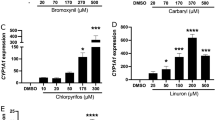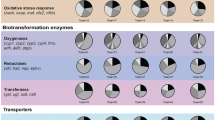Abstract
Although p53 has been extensively studied in mammalian models, relatively little is known about its specific function in lower vertebrates. It has long been assumed that p53 pathways characterized in mammals apply to other vertebrates as well. Fish provide a useful model for the study of environmental carcinogenesis, and populations of fish inhabiting highly polluted environments provide information on the etiology of pollutant-mediated cancer. In this study, we investigated p53 protein and apoptosis induction in PLHC-1 (desert topminnow hepatocellular carcinoma), RTL-W1 (rainbow trout normal liver), and primary rainbow trout hepatocytes exposed to model chemotherapeutics. All of the chemicals used in these studies have been demonstrated to increase p53 protein levels and induce apoptosis in mammalian cell lines. In contrast, PLHC-1 p53 protein was not induced in response to any model mammalian p53 inducers following 24 h exposures. Additionally, both trout cell types demonstrated this same lack of p53 induction upon exposure to model chemotherapeutic drugs. PLHC-1 cells demonstrated an induction of apoptosis as measured by caspase-3 activation following exposure to all of the chemotherapeutics tested. Our results suggest that fish p53 may be activated differently from that of their mammalian counterparts, and that important differences may exist between phyla in the function and regulation of p53 as well as other mechanisms involved in environmental carcinogenesis.
This is a preview of subscription content, access via your institution
Access options
Subscribe to this journal
Receive 50 print issues and online access
$259.00 per year
only $5.18 per issue
Buy this article
- Purchase on Springer Link
- Instant access to full article PDF
Prices may be subject to local taxes which are calculated during checkout



Similar content being viewed by others
References
Appella E, Anderson CW . (2001). Eur J Biochem 268: 2764–2772.
Benjamin CW, Hiebsch RR, Jones DA . (1998). Mol Pharmacol 53: 446–450.
Bensaad K, Rouillard D, Soussi T . (2001). Oncogene 20: 3766–3775.
Blagosklonny MV . (2002). Int J Cancer 98: 161–166.
Cachot J, Cherel Y, Galgani F, Vincent F . (2000). Mutat Res 464: 279–287.
Cachot J, Flaman JM, Frebourg T, Leboulenger F . (2004). Gene 324: 97–104.
Cachot J, Galgani F, Vincent F . (1998). Comp Biochem Physiol C Pharmacol Toxicol Endocrinol 120: 351–356.
Caspari T . (2000). Curr Biol 10: R315–R317.
Colman MS, Afshari CA, Barrett JC . (2000). Mutat Res 462: 179–188.
Donehower LA, Harvey M, Slagle BL, McArthur MJ, Montgomery Jr CA, Butel JS et al. (1992). Nature 356: 215–221.
Finlay CA . (1993). Mol Cell Biol 13: 301–306.
Franklin TM, Lee JS, Kohler A, Chipman JK . (2000). Mar Environ Res 50: 251–255.
Fridman JS, Lowe SW . (2003). Oncogene 22: 9030–9040.
Fritsche M, Haessler C, Brandner G . (1993). Oncogene 8: 307–318.
Hightower LE, Renfro JL . (1988). J Exp Zool 248: 290–302.
Hollstein M, Sidransky D, Vogelstein B, Harris CC . (1991). Science 253: 49–53.
Houser S, Koshlatyi S, Lu T, Gopen T, Bargonetti J . (2001). Biochem Biophys Res Commun 289: 998–1009.
Johnstone RW, Ruefli AA, Lowe SW . (2002). Cell 108: 153–164.
Jones SN, Sands AT, Hancock AR, Vogel H, Donehower LA, Linke SP et al. (1996). Proc Natl Acad Sci USA 93: 14106–14111.
Kazianis S, Gan L, Della Coletta L, Santi B, Morizot DC, Nairn RS . (1998). Gene 212: 31–38.
Krause MK, Rhodes LD, Van Beneden RJ . (1997). Gene 189: 101–106.
Lane DP . (1992). Nature 358: 15–16.
Lee LE, Clemons JH, Bechtel DG, Caldwell SJ, Han KB, Pasitschniak-Arts M et al. (1993). Cell Biol Toxicol 9: 279–294.
Lee JH, Lee E, Park J, Kim E, Kim J, Chung J . (2003). FEBS Lett 550: 5–10.
Lowry OH, Rosebrough NJ, Farr AL, Randall RJ . (1951). J Biol Chem 193: 265–275.
Marechal V . (1997). Pathol Biol (Paris) 45: 824–832.
Matsubara H, Kimura M, Sugaya M, Koide Y, Gunji Y, Takegana K et al. (1999). Int J Oncol 14: 1081–1085.
Momand J, Wu HH, Dasgupta G . (2000). Gene 242: 15–29.
Nelson WG, Kastan MB . (1994). Mol Cell Biol 14: 1815–1823.
Okamura M, Hashimoto K, Shimada J, Sakagami H . (2004). Anticancer Res 24: 655–661.
Olivier M, Eeles R, Hollstein M, Khan MA, Harris CC, Hainaut P . (2002). Hum Mutat 19: 607–614.
Part P, Norrgren L, Bergstrom E, Sjoberg P . (1993). J Exp Biol 175: 219–232.
Pluquet O, Hainaut P . (2001). Cancer Lett 174: 1–15.
Qian H, Wang T, Naumovski L, Lopez CD, Brachmann RK . (2002). Oncogene 21: 7901–7911.
Sandbacka M, Isomaa B . (2000). Comp Biochem Physiol C Toxicol Pharmacol 127: 307–315.
Schlenk D, Rice CD . (1998). Aquat Toxicol 43: 121–129.
Sekelsky JJ, Brodsky MH, Burtis KC . (2000). J Cell Biol 150: F31–F36.
Sueiro RA, Jenkins GJ, Lyons BP, Harvey JS, Parry JM . (2000). Mutat Res 468: 63–71.
Thisse C, Neel H, Thisse B, Daujat S, Piette J . (2000). Differentiation 66: 61–70.
Wallingford JB, Seufert DW, Virta VC, Vize PD . (1997). Curr Biol 7: 747–757.
Wang Y, Rea T, Bian J, Gray S, Sun Y . (1999). FEBS Lett 445: 269–273.
Xu Y . (2003). Cell Death Differ 10: 400–403.
Yang Y, Li CC, Weissman AM . (2004). Oncogene 23: 2096–2106.
Zambetti GP, Levine AJ . (1993). FASEB J 7: 855–865.
Acknowledgements
Flounder p53 polyclonal antibody was a generous gift from Dr Jerome Cachot (University of Le Havre, France). RTL-W1 cell lines were kindly given by Dr Niels Bols and Mary Lamb (University of Waterloo, Ont, Canada). Rainbow trout were donated by the North Carolina State Fish Hatchery (Marion, NC, USA). This work was supported through the NIEHS Superfund Basic Research Program (ES10356), NIH Integrated Toxicology Program (ES07031), and EPA STAR Fellowship to MRE (U-915461-01-1).
Author information
Authors and Affiliations
Corresponding author
Rights and permissions
About this article
Cite this article
Rau Embry, M., Billiard, S. & Di Giulio, R. Lack of p53 induction in fish cells by model chemotherapeutics. Oncogene 25, 2004–2010 (2006). https://doi.org/10.1038/sj.onc.1209238
Received:
Revised:
Accepted:
Published:
Issue Date:
DOI: https://doi.org/10.1038/sj.onc.1209238
Keywords
This article is cited by
-
Acute and sub-chronic toxicity of four cytostatic drugs in zebrafish
Environmental Science and Pollution Research (2016)
-
Characterization of the tilapia p53 gene and its role in chemical-induced apoptosis
Biotechnology Letters (2012)
-
Fish as model systems for the study of vertebrate apoptosis
Apoptosis (2009)
-
Aflatoxins in aquatic species: metabolism, toxicity and perspectives
Reviews in Fish Biology and Fisheries (2008)
-
Urodele p53 tolerates amino acid changes found in p53 variants linked to human cancer
BMC Evolutionary Biology (2007)



